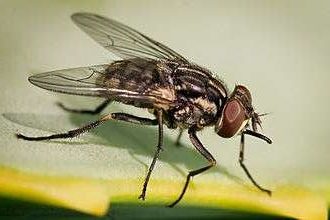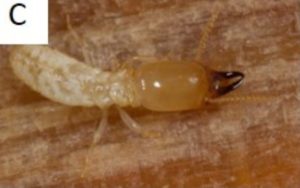Presentation of a species of ants encountered during my stay at STRI au Panama
- Flying ants of the genus Cephalotes
Ants of the genus Cephalotes (Family Myrmicinae and Tribe Cephalothini) are mainly present in tropical forests of Central and South America.
caption id=”attachment_1307″ align=”alignright” width=”204″] Cephalotes at the entrance of their nest in a tree barter – ©Photo B. GILLES[/caption]
Cephalotes at the entrance of their nest in a tree barter – ©Photo B. GILLES[/caption]
These are only tree species, building their nests in living or dead tree stems and trunks. Their biology is not very well known, but they seem to feed on a wide range of plant and animal foods (pollen, insects, bird droppings, dead animals, etc.), they are considered omnivores. The colonies, according to the species, contain from a dozen workers to nearly 10 000 as in Cephalotes atratus.
These ants are known by their singular morphology. All species of this genus are characterized by a thick cuticle (learn more about the cuticle here) that gives them an “armored” appearance and by a dorso-ventral flattening of the body, especially the head (see photo below). A system of caste exists in some of these species, i.e. that individuals are specific to a task and have an adapted morphology (read these articles Atta and Eciton). We therefore find workers and soldiers, the latter having a more pronounced flattening. These species are called dimorphic (opposite to monophorm). This morphology has evolved and selected as a defence. To protect themselves, ants flatten themselves on the support to avoid being caught by the predator. Some of these species also use chemical secretions causing nauseating odours in order to repel the predator.

The defense effectiveness of Cephalotes is such that many species of insects and arthropods (wasps, bugs, beetles and spiders) mimic the morphology of these ants to escape and fool predators (see photo opposite). This phenomenon is called Batesian imitation, which consists of a harmless species resembling a species feared and inedible by predators (example of butterflies Heliconius).
– The first interesting and exciting feature of these ants is that they use their flat, plate-shaped head to block the entrance to their nest (see photos below). To do this, each species, of different sizes, must occupy a nest whose openings must match the diameter of their heads. Thus, each species occupies a nest adapted to its morphology. Scientists therefore hypothesize that only lines adapted to an opening size in the stems could be selected during evolution. This process has led to the emergence of numerous species, each adapted to a specific nest opening diameter.



– The second most surprising characteristic is their ability to direct their fall to find the tree from which they fell. All species of Cephalotes studied showed this faculty (see video). This ability allows them to find their way back to their nest more easily than if they fell to the ground. Indeed, ants locate themselves using chemical traces (pheromones) left on the substrate, the support by their congeners. Falling on the ground decreases the chances of finding traces (getting lost in the foliage), and increases the chances of being killed (flooded soil, predation…). Colonies are sometimes more than 30-40m high, studies have estimated that 85% of ants manage to land on the original trunk, even at speeds of 4 meters per second!
The way ants control their fall and land on the trunk is not yet well characterized. It seems that they are able to rotate 180° and position the abdomen and legs facing the trunk. Most incredible, despite a failed landing, ants are able to reorient themselves to make a second attempt.
Evolution selected this capability during evolution because most Cephalotes live in the canopy several tens of meters high. The lines of ants whose individuals had this faculty, were thus positively selected during the evolution.
Source :
– Yanoviak S.P. & Dudley R. (2006) : The role of visual cues in directed aerial descent of Cephalotes atratus workers (Hymenoptera – Formicidae). Journal of Experimental Biology, 209:1777-1783 (lien)
Recommendations of works on this theme:
– Les Ants: Behavior, Social Organization and Evolution (Luc Passera – Edition : Canadian Science Publishing – 480 pages – January 2005)
– The world of ants (Rémy Chauvin – Edition : Editions du Rocher – 285 pages – 2 October 2003)
– Le monde extraordinaire des fourmis (Luc Passera – Edition : Fayard – 235 pages – 13 mars 2008)
– Ant Ecology (Lori Lach, Catherine Parr & Kriti Abbott – Edition : OUP Oxford – 424 pages – 10 juin 2010)





